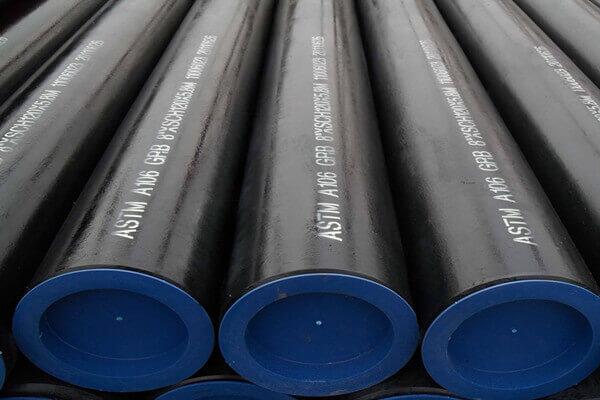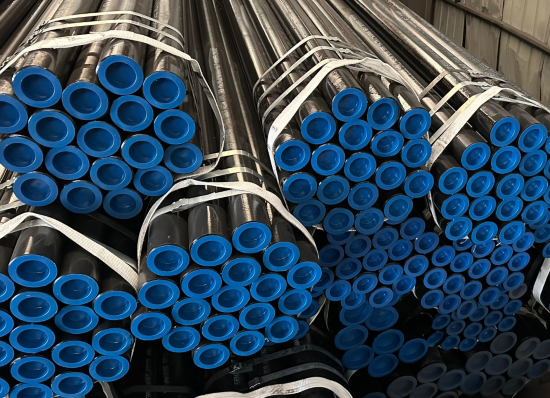
ASTM A106 - Standard specification for seamless carbon steel pipe for high-remperature service.
ASTM A106 Seamless Pipe (also known as ASME SA106 pipes) belongs to the American standard, which contains steel grade: A106 Gr.A; A106 Gr.B; A106 Gr.C. It used in different industries not only for pipeline systems like oil and gas, water, mineral slurry transmission, but also for boiler, construction, structural purposes. ASTM A106 pipe is always produced by the seamless method and can be bent, coiled and flanged.
Sizes
1” – 26” dependent on OD vs Wall Ratio

About ASTM A106 Grade B:
ASTM A106 Grade B Pipe (also known as ASME SA106 GR.B pipes) is used in power plants, boilers, petrochemical plants, oil and gas refineries, and ships where the piping must transport hot or cold liquids and gases under high pressures and temperatures. A106 GR. B Carbon Steel Seamless Pipes, A106 Gr B Sch 40 pipe, ASTM A106 Grade B Pipe Suppliers is available in various weights, sizes, and black and galvanized grades both seamless and electric welded. ASTM A106 Grade B Pipe sizes, less than 2" is it normally delivered as a cold drawn product. 2" and up are usually hot finished.
About ASTM A106 Grade C:
ASTM A106 Grade C Pipe (also known as ASME SA106 GR.C pipes) is a carbon-manganese steel pipe for high-temperature large-diameter boilers and superheaters. Its chemical composition is simple and similar to 20G carbon steel, but its carbon and manganese content is higher, so its yield strength is about 12% higher than that of 20G, and its plasticity and toughness are not bad. The steel has a simple production process and good cold and hot workability. Using it to replace 20G headers (economizer, water wall, low-temperature superheater and reheater header) can reduce the wall thickness by about 10%, which can save material costs, reduce welding workload, and improve headers The stress difference at start-up.
Mechanical Properties:
|
Steel Grade |
Tensile Strength(Mpa) |
Yield Strength(Mpa) |
Elongation(%) |
Delivery Condition |
| A |
≥330 |
≥205 |
20 |
Annealed |
| B |
≥415 |
≥240 |
20 |
Annealed |
| C |
≥485 |
≥275 |
20 |
Annealed |
Chemical Composition:
| Element | Grade A | Grade B | Grade C |
| Carbon max. % | 0.25 | 0.30 | 0.35 |
| Manganese % | 0.27 – 0.93 | 0.29 – 1.06 | 0.29 – 1.06 |
| Phosphorus max % | 0.035 | 0.035 | 0.035 |
| Sulfur max % | 0.035 | 0.035 | 0.035 |
| Silicon, min % | 0.10 | 0.10 | 0.10 |
Comparison with other standards:
ASTM A53: Low temperature and low pressure general purpose pipeline
Main difference: lower strength, not suitable for high temperature and high pressure
API 5L: Special pipeline for oil and gas transportation
Main difference: focus on pressure resistance and corrosion resistance
ASTM A335: Alloy steel high temperature pipeline (such as P11)
Main difference: chromium-molybdenum alloy, resistant to higher temperatures

Typical applications:
ASTM A106 seamless pipe is suitable for high temperature and high pressure transportation systems (such as steam, oil and gas, etc.), with an operating temperature range of -29°C to 650°C. It can withstand high pressure and is suitable for oil and natural gas pipelines and boiler systems. Special treatments (such as normalizing and tempering) can improve corrosion resistance and are suitable for oil and gas environments containing hydrogen sulfide (H₂S), in line with NACE MR0175 standards. It has good weldability, low carbon design (C≤0.35%) reduces the risk of welding cracks, and preheating (such as 150°C) is required to optimize weld quality.
Oil and gas: oil pipelines, wellhead equipment, gathering and transportation pipelines.
Power industry: thermal power plant boiler tubes, steam pipelines.
Chemical equipment: high temperature reactors, heat exchanger pipelines.
Building and machinery: structural support, hydraulic system.
Production process:
ASTM A106 seamless steel pipe includes two processes, cold drawn and hot rolled. In addition to the different production processes, the two are different in precision, surface quality, minimum size, mechanical properties, and organizational structure. It is widely used in various industries such as petroleum, chemical industry, boiler, power station, shipbuilding, machinery manufacturing, automobile, aviation, aerospace, energy, geology, construction and military industry.
Heat treatment:
Hot-finished pipe need not be heat treated.When hot finished pipe is heat treated, it shall be heat treated at a temperature of 1200°F(650℃) or higher.
Cold drawn pipe shall be heat treated after the final cold draw pass at a temperature of 1200°F(650℃) or higher.
Read more: ASTM A53 Pipe Specification or Steel Pipe Dimensions & Sizes Chart
